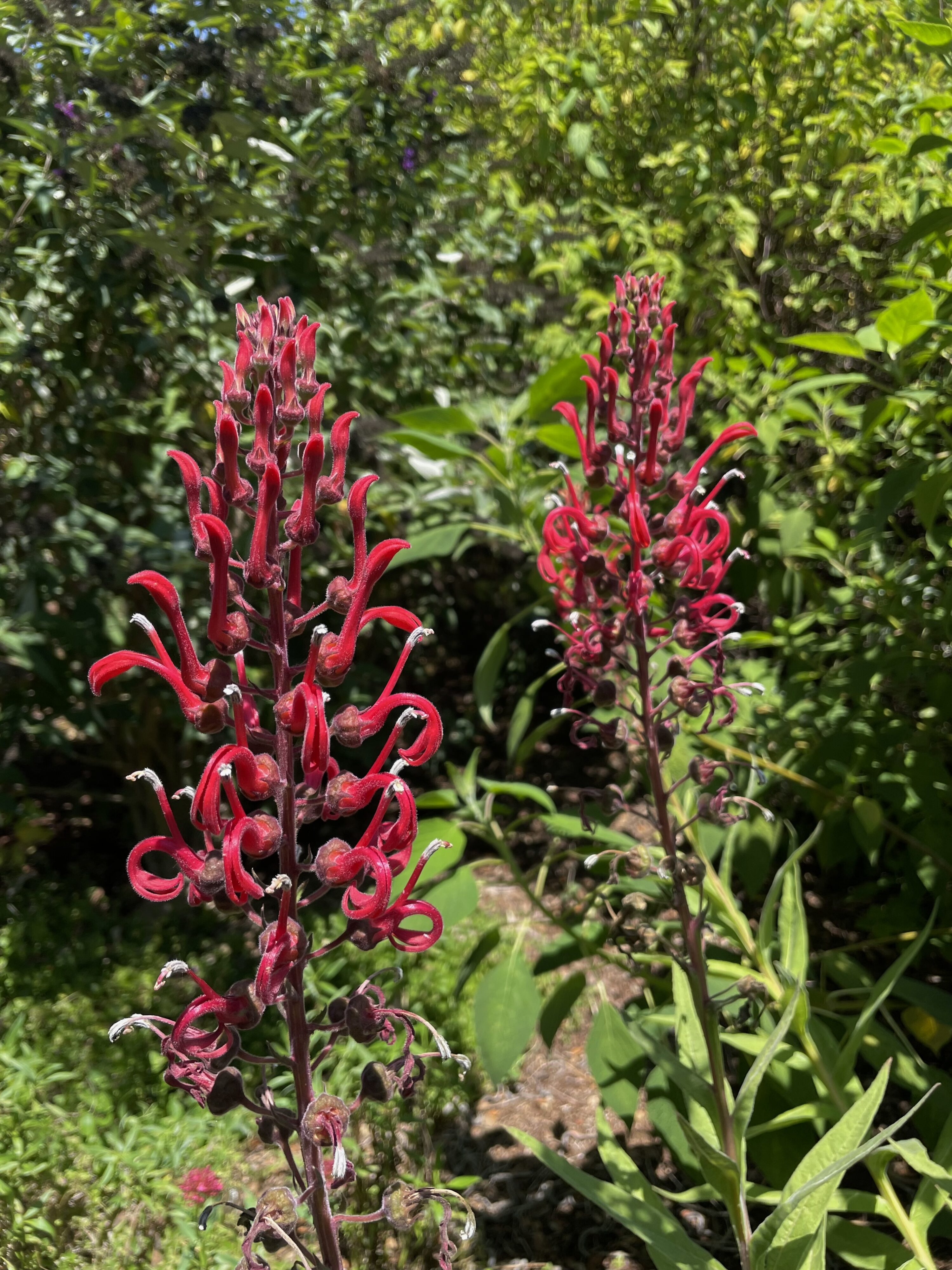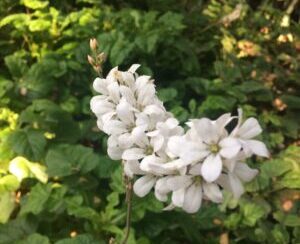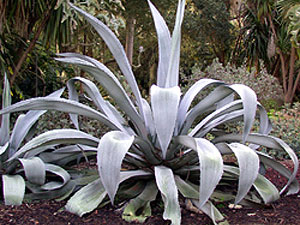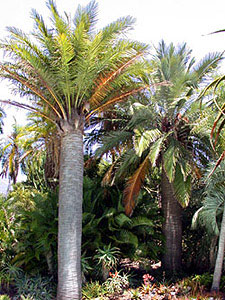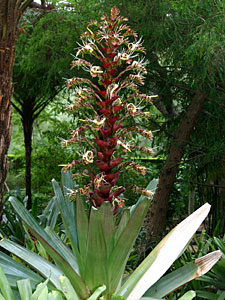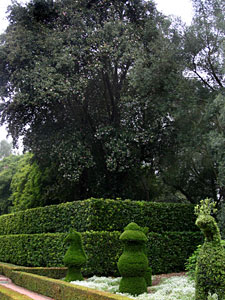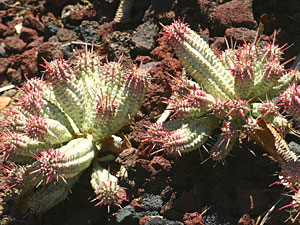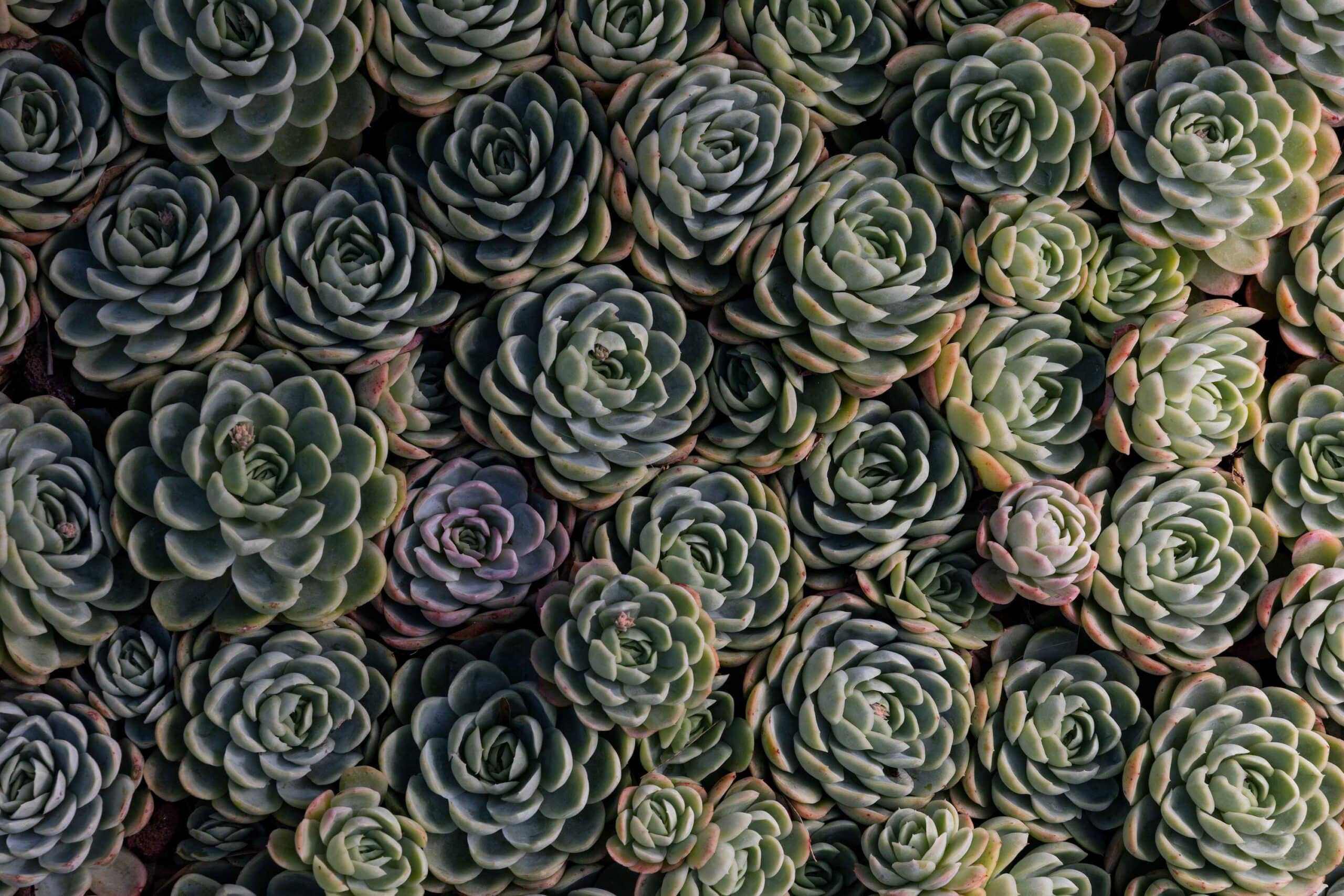
Plant Highlights
August
-
Agave ellemeetiana
Ellemeet’s agave
Highlight Month:
August
Nativity:
This species was originally described in 1865 from material in European gardens but was recently re-discovered in the cloud forests of Mexico. Two subspecies exist: A. ellemeetiana ssp. ellemeetiana (from Veracruz and northern Oaxaca) with smooth leaf margins; and A. ellemeetiana ssp. subdentata (from western Oaxaca) with fine teeth, or denticles, on the margins.
Growth Habit:
This solitary agave lacks dangerous teeth on the margin and reaches large proportions in the garden. Its reflexed shiny green leaves are waxy and may turn slightly reddish at the tips when grown in full sun. Agave ellemeetiana superficially resembles A. attenuata, arguably the most common agave in Santa Barbara cultivation, but lacks the upright stem and blue, glaucous coloration to the leaves.
Growing Requirements:
Agave ellemeetiana is hardy to USDA Zone 10 and prefers full sun in coastal habitats and part shade when grown inland. Individual plants will reach 2-3’ tall and wide. It is one of the more shade tolerant agave species and grows on rocky cliff faces in cloud forest habitat alongside orchids and bromeliads. Consistent watering is recommended.
Features:
The specific epithet honors Jonkheer Willem Cornelis Mary de Jonge van Ellemeet (1811-1888), Dutch landowner, mayor, and holder of an extensive Agave collection at his estate near Oostkapelle in the Netherlands.
Where at Lotusland:
Agave ellemeetiana ‘Satina’ can be found at Lotusland near the Sycamore Canyon Road gate mixed in with the glaucous blue Agave franzosinii.

-
Salvia guaranitica
anise-scented sage
Highlight Month:
August
Nativity:
Brazil to Northern Argentina.
Growth Habit:
This large and attractive plant blooms mid-summer to fall with blue-purple petals and green to blue-black calyxes. The flowers are popular with hummingbirds and butterflies. Several cultivars available in the nursery trade have been selected for varying flower colors such as ‘Black and Blue’, ‘Argentine Skies’, and ‘Blue Enigma’.
This perennial Saliva can grow over 6’ tall in the Santa Barbara area but can be pruned in spring to branch at a lower height. Leaves are held in an opposite arrangement on the stem, are dark green in color, and have a mild anise-scent with crushed. Spreading underground rhizomes form a large patch and, in more temperate regions, can be overwintered indoors for planting the following season. Stem cuttings are also easy to root.
Growing Requirements:
S. guaranitica is hardy to USDA Zones 8-10, prefers full sun to part-shade, and is moderately drought tolerant once established.
Features:
The genus name, Salvia, comes from the Latin, salvus, meaning “to make safe or healthy” in reference to the healing properties of many sages. The specific epithet, guaranitica, refers to the Brazilian city of Guará, where this species is found.
Where at Lotusland:
At the back of the Cycad Garden.
-
Lobelia tupa
Highlight Month:
August
Nativity:
Chile
Growth Habit:
Perennial that forms a 4’ wide clump and can reach heights of 6-8’. Blooms in mid to late summer and will lightly reseed in the garden if flower stalks are left over the autumn. The bright red flowers attract hummingbirds, bees, and butterflies and its broad grey-green leaves resemble the tobacco plant.
Growing Requirements:
L. tupa prefers full sun, minimal summer water after its first year, and is winter deciduous.
Features:
Use caution when handling this plant as it may irritate the skin and eyes. Contains the alkaloid lobeline which has similar effects upon the nervous system as nicotine.
Where at Lotusland:
Insectary Garden
-
Cleyera japonica
sakaki
Highlight Month:
August
Nativity:
Japan, Korea, China
Growth Habit:
Cleyera japonica, is a broadleaf evergreen shrub. In the wild, this species grows into a small tree, but when cultivated tends to develop a shrubbier habit, reaching 8-10’ tall by 6-10’ wide. New growth emerges a reddish bronze and fades to dark green. Fragrant creamy white flowers appear in mid-summer.
Growing Requirements:
Requires regular irrigation, well drained soils, and light shade.
Features:
It is considered a sacred tree to Japanese mythology and Shinto ritual and is used to construct tamagushi, an offering made of a sakaki branch decorated with strips of washi paper, silk, or cotton.
Where at Lotusland:
Japanese Garden
-
Francoa ramosa
bridal wreath
Highlight Month:
August
Nativity:
Chile
Growth Habit:
Francoa is a perennial plant which produces a clump of wavy-edged basal leaves, each to one foot long, with the plant itself reaching 1-2 feet high. It spreads by rhizomes, and is easily divided.
Growing Requirements:
Francoa grows best in partial shade with moderate water. It will tolerate temperatures slightly below freezing.
Features:
In summer, a profusion of multi-stemmed flower spikes rise up over the foliage on stalks up to 3 ft tall. Each stalk bears many small flowers which may be pure white or blushed with pink. The blooms made good cut flowers.
Where at Lotusland:
A planting of Francoa is growing in the Fern Garden.
-
Agave franzosinii
Highlight Month:
August
Nativity:
A. franzosinii is only known from cultivated plants in Europe and the United States.
Growth Habit:
This large agave is easy to spot, with glaucous blue arching leaves. Be sure to leave room in your garden for this plant as it can reach 8 feet tall and 10 feet wide! Known only in cultivation, this species exhibits variation in leaf shape and color due to seedling variation. The plant will occasionally send out offshoots from underground rhizomes. The flower stalks may reach over 30 feet tall. After flowering, the plant dies.
Growing Requirements:
Full sun, requires little water once established.
Features:
A. franzosinii has large curving whitish-blue or gray leaves. The plant seldom flowers, but when it does it produces a huge spike of yellow flowers in summer which attract birds and insects.
Where at Lotusland:
A mixed planting of Agave franzosinii and Agave americana borders the Main Lawn.
-
Jubaea chilensis
Chilean wine palm, coquito palm
Highlight Month:
August
Nativity:
Central Chile. These palms are rare in the wild, due to centuries of being felled for their sap which is very sweet and is used as a sugar extract or fermented for wine. They are now protected by the Chilean government.
Growth Habit:
A very slow-growing palm which at maturity reaches 75 feet tall with a trunk over three feet across. Most have hanging lower fronds, but some have a more upright crown; both forms can be seen in the picture to the left.
Growing Requirements:
This palm grows well in temperate subtropical climates, though not in the true tropics. It is cold-tolerant and can withstand frost even when young. It grows best in full sun and well-drained soil.
Features:
Jubaea chilensis has a thick gray trunk crowned with feathery grey-green fronds. It has very small flowers, which grow on a 4′ long stalk hidden under the leaves. These are followed by orange fruit. The common name ‘coquito’ refers to the one-inch nut inside the fruit. These look and taste like miniature coconuts.
Where at Lotusland:
There are approximately 40 mature Chilean wine palms at Lotusland dating back to the early years of the estate when it was owned by Ralph Kinton Stevens (1882-1913). They are planted mainly in the Blue Garden and Aloe Garden. Young specimens have been planted in the Cactus Garden and at the visitors’ entrance gate on Cold Spring Road.
-
Alcantarea imperialis
Highlight Month:
August
Nativity:
Mountains outside Rio de Janeiro, Brazil
Growth Habit:
This is one of the larger bromeliads, forming a rosette of leathery leaves up to 4 feet across. In nature it grows clinging to rock faces, slowly accumulating fallen organic debris to create its own soil.
Growing Requirements:
Plant in humus-rich soil in light shade and keep moist.
Features:
It may take plants ten years or more to reach blooming size. Once the large inflorescence is finished, the plant dies, but it usually makes one or more offsets that can be removed and grown on.
Where at Lotusland:
Several in the Upper and Lower Bromeliad Gardens.
-
Lagunaria patersonia
cow itch tree, primrose tree
Highlight Month:
August
Nativity:
Lord Howe and Norfolk Islands and coastal Queensland, Australia
Growth Habit:
Large, evergreen tree to 40 to 50 feet, becoming pyramidal in old age.
Growing Requirements:
Tolerates drought, salt spray and many soil types. It is frost tolerant to 23° F.
Features:
Seed capsules are filled with tiny irritating hairs, giving it the common names cow itch or itchy bomb tree.
Where at Lotusland:
Behind the hedges of the Parterre below the Star Fountain.
-
Euphorbia mammillaris ‘Variegata’
variegated corn cob euphorbia
Highlight Month:
August
Nativity:
Garden Origin
Growth Habit:
The corn cob euphorbia is a small, branching succulent plant. It grows only about 6 to 8 inches tall.
Growing Requirements:
Like all succulent euphorbias, this species requires excellent drainage and a sunny location.
Features:
Called the corn cob euphorbia because it has a knobby surface, this variegated form is pale green most of the year. The tips become noticeably pink in cooler weather or when the plant is under other stressful conditions.
Where at Lotusland:
Among the amethyst chunks on the west side of the Main Drive.



